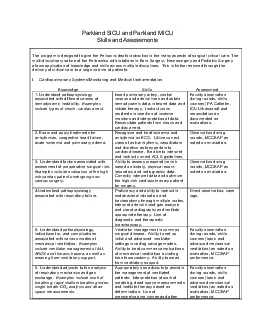

Resuscitation of injured patients operative management under graded supervision Faculty observation during rounds as documented on evaluation MCCKAP performance X Miscellaneous ID: 869332
Download Pdf The PPT/PDF document "factors associated with bleeding disorde..." is the property of its rightful owner. Permission is granted to download and print the materials on this web site for personal, non-commercial use only, and to display it on your personal computer provided you do not modify the materials and that you retain all copyright notices contained in the materials. By downloading content from our website, you accept the terms of this agreement.
1 factors associated with bleeding disorde
factors associated with bleeding disorders. Resuscitation of injured patients operative management under graded supervision. Faculty observation during rounds as documented on evaluation; MCCKAP performance. X. Miscellaneous Knowledge Skills
2 Assessment 1. Understand descriptive
Assessment 1. Understand descriptive and computational biostatistics and principles of experimental design and evidence based therapy. Critique articles at monthly journal club. Encourage participation in biweekly Understand the indications and physiology for ECMO. x Invasive and non-invasive monitoring techniques including central venous and
3 arterial access. Correctly assess a c
arterial access. Correctly assess a childÕs nutritional status and Faculty observation during immunization schedules. x Correctly interpret culture data and use antibiotics appropriately. Faculty observation during rounds as documented on evaluation. evaluation. Neurologic System x Understand the physiology of brain injury in children. x Un
4 derstand the management of increased int
derstand the management of increased intra-cranial pressure in children. x Performance of a complete neurological examination in children of various ages. x Interpretation of EEG data x Interpretation and trouble-shooting of intra-cranial pressure monitoring. Faculty observation during evaluation. Administration/Ethics x Understand the legalitie
5 s of end-of-life issues including withdr
s of end-of-life issues including withdrawal of support, organ donation in children. x Understand the role of the surgeon in the Pediatric ICU. x Understand the criteria for admission and discharge from the ICU. x Understand the Performance Improvement process. general thoracic surgical conditions. Examples include the pathophysiology of the coron
6 ary circulation; acquired valvular disea
ary circulation; acquired valvular disease, pericardial disease, and cardiac tumors; valvular prostheses and their complications; alternate conduits for coronary artery bypass grafting; cardiopulmonary bypass and myocardial protection. -Bedside demonstration of knowledge of common cardiothoracic pathology and its management Faculty observation durin
7 g rounds as documented on evaluation. T
g rounds as documented on evaluation. The SCC resident should be able to demonstrate knowledge of the preoperative assessment, perioperative management and postoperative care of cardiothoracic patients. Examples include assessment of patient risk, identification and management of co-morbid conditions, and principles of postoperative pain management
8 and wound care. -Demonstration of preop
and wound care. -Demonstration of preoperative risk assessment and stratification -Appropriate management and consultation strategies for postoperative pain management Faculty observation during rounds as documented on evaluation. The SCC resident should be able to efficiently utilize and interpret diagnostic laboratory testing. Examples include
9 interpretation of arterial blood gas res
interpretation of arterial blood gas results, coagulation the ICU setting. Examples include the pathophysiology of myocardial dysfunction and heart failure, respiratory failure, coagulation derangements, atrial and ventricular arrhythmias, and surgical infections. -Management of acute coronary liver resection for injury, placement of Shrock shunt
10 ; repair of abdominal, chest, or pelvic
; repair of abdominal, chest, or pelvic vascular injury; pancreatic resection for trauma; duodenal diverticularization; nephrectomy for trauma; repair of ureteral injury. Faculty observation during rounds as documented on evaluation. The SCC resident should be able to management of penetrating neck injuries, management of colon injuries, and manage
11 ment of minimal vascular injuries. Unde
ment of minimal vascular injuries. Under appropriate supervision, the SCC resident should be able to manage SCC resident should demonstrate the ability to perform these advanced operative procedures. Faculty observation during rounds as documented on evaluation. The SCC resident should be able to correctly explain the indications and contraindica
12 tions for diagnostic and therapeutic end
tions for diagnostic and therapeutic endoscopy in the acute setting. The SCC resident should be able to correctly utilize consultants while remaining responsible for ultimate patient care. Faculty observation during rounds as documented on evaluation. The SCC resident should be able to discuss the management alternatives for common bile duct stones
13 . Under appropriate supervision, the SC
. Under appropriate supervision, the SCC resident should demonstrate the ability to perform these advanced operative procedures or order jury, status epilepticus, neuromuscular diseases, and comaWhile the core goals and objectives are identical to those of the SICU and MICU rotations, goals and objectivesspecific to the neurocritical care rotation
14 will be as follows:
will be as follows: Knowledge Skills Assessment Develop core neurocritical care skills such as review of CT/MRI scans and manalgement of ischemic and hemorrhagic stroke, traumatic brain injury, increased ICP, hydrocephal
15 us, seizure, hypertension, cerebral salt
us, seizure, hypertension, cerebral salt wasting and vasospasm. Demonstrate proficiency at the bedside in the management of these conditions. Faculty observation during rounds as documented on evaluation; MCCKAP performance. To be familiar with the epidemiology and risk factors for commonly encountered ICU conditions including ischemic stroke, ICH,
16 SAH, TBI, and seizure. Be able to verb
SAH, TBI, and seizure. Be able to verbalize same as they impact the management of NCC Faculty observation during rounds as documented on evaluation; MCCKAP performance. To know the signs, symptoms, clinical course, complications and treatment of common post-operative conditions for neurosurgical specialty operations. Be able to verbalize same as